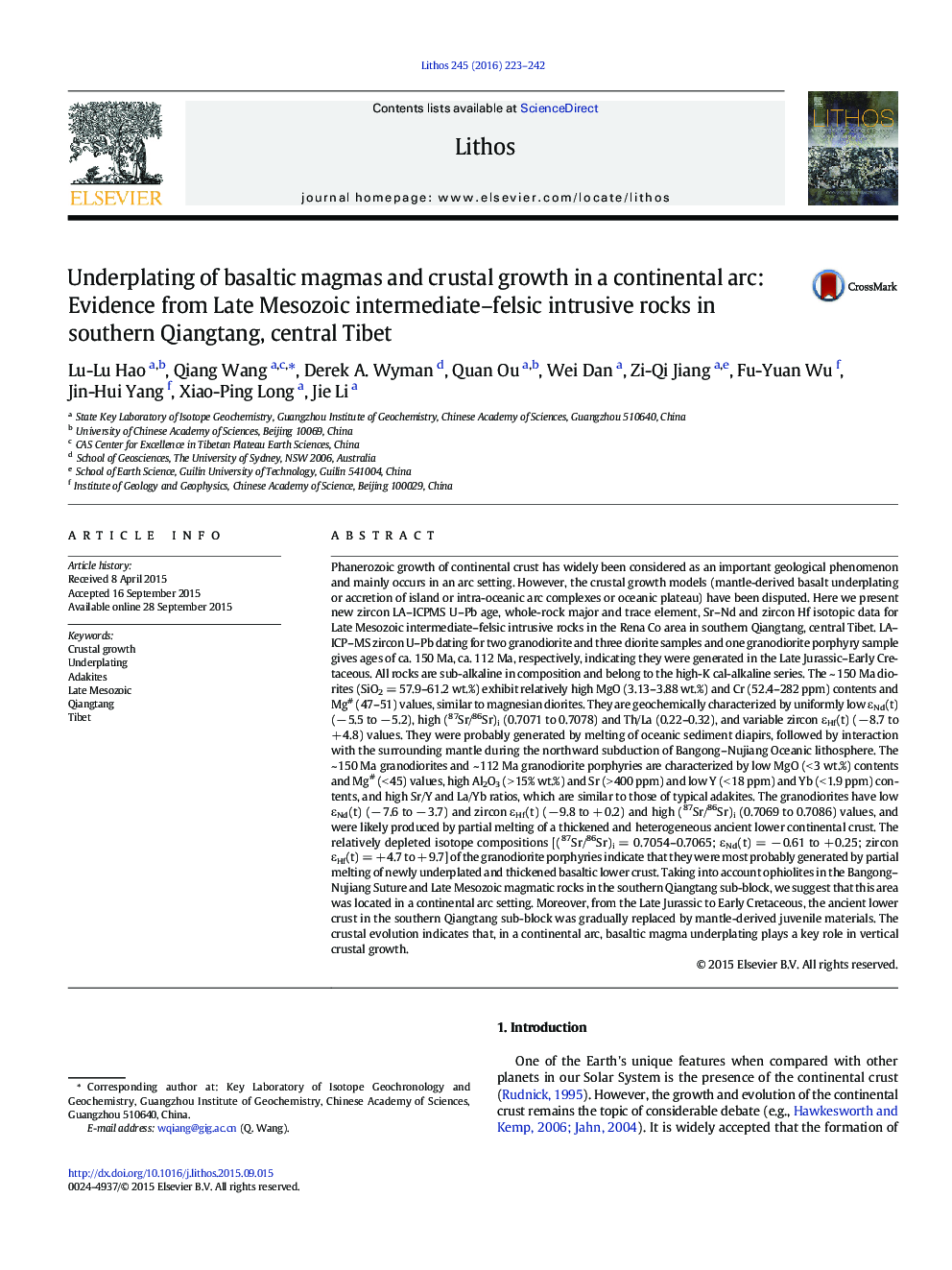| کد مقاله | کد نشریه | سال انتشار | مقاله انگلیسی | نسخه تمام متن |
|---|---|---|---|---|
| 4715537 | 1638651 | 2016 | 20 صفحه PDF | دانلود رایگان |

• Late Mesozoic intermediate–felsic intrusive rocks in southern Qiangtang, Tibet
• ~ 150 Ma diorites generated by melting of oceanic sediment diapirs
• ~ 150 Ma granodiorites mainly derived from thickened ancient lower continental crust
• 112 Ma granodiorite porphyries mainly originating from newly underplated basaltic lower crust
• Underplating of juvenile arc basaltic magmas plays an important role in crustal growth.
Phanerozoic growth of continental crust has widely been considered as an important geological phenomenon and mainly occurs in an arc setting. However, the crustal growth models (mantle-derived basalt underplating or accretion of island or intra-oceanic arc complexes or oceanic plateau) have been disputed. Here we present new zircon LA–ICPMS U–Pb age, whole-rock major and trace element, Sr–Nd and zircon Hf isotopic data for Late Mesozoic intermediate–felsic intrusive rocks in the Rena Co area in southern Qiangtang, central Tibet. LA–ICP–MS zircon U–Pb dating for two granodiorite and three diorite samples and one granodiorite porphyry sample gives ages of ca. 150 Ma, ca. 112 Ma, respectively, indicating they were generated in the Late Jurassic–Early Cretaceous. All rocks are sub-alkaline in composition and belong to the high-K cal-alkaline series. The ~ 150 Ma diorites (SiO2 = 57.9–61.2 wt.%) exhibit relatively high MgO (3.13–3.88 wt.%) and Cr (52.4–282 ppm) contents and Mg# (47–51) values, similar to magnesian diorites. They are geochemically characterized by uniformly low εNd(t) (− 5.5 to − 5.2), high (87Sr/86Sr)i (0.7071 to 0.7078) and Th/La (0.22–0.32), and variable zircon εHf(t) (− 8.7 to + 4.8) values. They were probably generated by melting of oceanic sediment diapirs, followed by interaction with the surrounding mantle during the northward subduction of Bangong–Nujiang Oceanic lithosphere. The ~ 150 Ma granodiorites and ~ 112 Ma granodiorite porphyries are characterized by low MgO (< 3 wt.%) contents and Mg# (< 45) values, high Al2O3 (> 15% wt.%) and Sr (> 400 ppm) and low Y (< 18 ppm) and Yb (< 1.9 ppm) contents, and high Sr/Y and La/Yb ratios, which are similar to those of typical adakites. The granodiorites have low εNd(t) (− 7.6 to − 3.7) and zircon εHf(t) (− 9.8 to + 0.2) and high (87Sr/86Sr)i (0.7069 to 0.7086) values, and were likely produced by partial melting of a thickened and heterogeneous ancient lower continental crust. The relatively depleted isotope compositions [(87Sr/86Sr)i = 0.7054–0.7065; εNd(t) = − 0.61 to + 0.25; zircon εHf(t) = + 4.7 to + 9.7] of the granodiorite porphyries indicate that they were most probably generated by partial melting of newly underplated and thickened basaltic lower crust. Taking into account ophiolites in the Bangong–Nujiang Suture and Late Mesozoic magmatic rocks in the southern Qiangtang sub-block, we suggest that this area was located in a continental arc setting. Moreover, from the Late Jurassic to Early Cretaceous, the ancient lower crust in the southern Qiangtang sub-block was gradually replaced by mantle-derived juvenile materials. The crustal evolution indicates that, in a continental arc, basaltic magma underplating plays a key role in vertical crustal growth.
Journal: Lithos - Volume 245, 15 February 2016, Pages 223–242